Reimagining Urban Cemeteries: Behavioral Patterns, Perceptions, and Intentions in Tokyo’s Public Burial Landscapes
Abstract
1. Introduction
- How are metropolitan public cemeteries currently used by visitors in Tokyo?
- What types of emotional responses and perceived landscape elements are associated with these cemetery visits?
- How are observed behaviors related to emotional responses and environmental perception?
- What are the levels and patterns of public willingness to engage in non-commemorative behaviors in cemetery spaces?
- How do patterns of use, perception, and behavioral intention vary between urban and suburban cemetery settings?
2. Materials and Methods
2.1. Study Area
2.2. Research Design
2.3. Social Media Data Analysis
2.3.1. Social Media Data on Public Cemeteries in Tokyo
2.3.2. Topic Modeling
2.3.3. Behavior Extraction
2.3.4. Emotion Detection
2.3.5. Image Feature Extraction
2.3.6. Co-Occurrence Analysis of Visual Features
2.4. Survey Design and Analysis
2.4.1. Participant Recruitment and Group Classification
2.4.2. Questionnaire Structure
2.4.3. Statistics Analysis
3. Results
3.1. Analysis of Online Reviews
3.1.1. Topic Modeling Results
3.1.2. Behavioral and Sentiment Patterns
3.2. Visual Element Analysis
3.2.1. Visual Features Extraction
3.2.2. Association Between Behaviors and Visual Features
3.3. Behavioral Intentions Analysis
3.3.1. Comparison of Behavioral Intentions Across Visitor Groups
3.3.2. Comparison of Behavioral Intentions Across Cemetery Types
3.3.3. Factor Analysis of Behavioral Intentions and Group Differences
4. Discussion
4.1. Patterns of Cemetery Use in Tokyo
4.2. Affective and Environmental Dimensions of Cemetery Behaviors
4.3. Latent Dimensions of Non-Commemorative Engagement
4.4. Who Has the Right to Act? Relational Legitimacy in Cemetery Spaces
4.5. Contextual Variations in Cemetery Engagement: Urban and Suburban Variations
4.6. Aligning Policy Vision with Public Experience in Cemetery Management
4.7. Limitations and Future Work
5. Conclusions
Author Contributions
Funding
Data Availability Statement
Conflicts of Interest
Abbreviations
| CV | Commemorative Visitors |
| MPV | Multi-purpose Visitors |
| NV | Non-visitors |
Appendix A

Appendix B
| Category | Definition | Representative Examples from Reviews |
|---|---|---|
| Nature Enjoyment | Expressions of appreciation for natural elements such as trees, flowers and seasons. | “Beautiful cherry blossoms.” “Loved the quiet greenery.” |
| Cultural and Historical Engagement | References to historical knowledge, cultural heritage, or famous individuals associated with the cemetery. | “Visited the grave of a historical figure.” “Reminded me of the Showa era.” |
| Spirituality and Tranquility | Descriptions of emotional calm, spiritual reflection, or a peaceful atmosphere. | “Felt very serene and calming.” “A sacred and quiet place.” |
| Leisure Walking | Walking for pleasure or relaxation. | “Took a walk in the cemetery.” “Nice place for a stroll.” |
| Environment Evaluation | Comments evaluating the physical condition, cleanliness, layout, or design of the space. | “Very well maintained.” “Really big and easy to get lost.” |
| Everyday Mobility | Use of the cemetery as a route for passing through or shortcutting between other destinations, such as commuting or accessing nearby places. | “Used it as a shortcut.” “Walked through on my way to the station.” |
| Physical Activity | Engagement in physically active or mobile behaviors within the cemetery, including jogging, cycling, or walking a dog. | “Went for a jog.” “Rode my bike through the paths.” |
| Social Interaction | Non-commemorative, person-to-person engagement within the cemetery, including casual conversations or shared activities with friends, partners, or family members. | “Talked with an old man I met in the cemetery.” “Enjoying a picnic on the lawn.” |
| Photography | Mention of taking, sharing, or admiring photographs of the cemetery space. | “Great spot for photography.” “Took lots of pictures.” |
| Event Participation | Participation in non-ritual events or community-led activities held within the cemetery. These include educational, environmental, or cultural programs that do not involve direct commemorative or religious practices. | “Participated in a community-led moss cleaning event.” “Participated in a guided tour about old trees.” |
Appendix C
| Visual Feature Category | Descriptions | Labels |
|---|---|---|
| Arboreal and Vegetative Elements | Tree and plant-related features reflecting natural and ecological aspects. | branch, woody plant, twig, tree, trunk, leaf, shrub, groundcover, evergreen, vegetation, conifers, plants, wood, plant community, pine family, botanical garden, green, grass, larch, temperate broadleaf and mixed forest, Cupressaceae, plant stem, old-growth forest, woodland, perennial plant |
| Floral and Seasonal Indicators | Floral and seasonal elements evoking aesthetic and cultural associations. | spring, blossom, petal, cherry blossom, flower, prunus, pink, flowering plant, flower arranging, floristry, autumn, flowerpot, houseplant, wildflower |
| Funerary and Burial Features | Core cemetery components related to commemoration and burial. | cemetery, headstone, grave, memorial, stele, monument, commemorative plaque, monolith, tomb |
| Public Space Attributes | Circulation and open space elements indicating spatial structure. | road surface, walkway, public space, thoroughfare, park, road, street, lane, public utility, pedestrian, yard, path, lawn, driveway |
| Architectural and Structural Components | Built environment features surrounding or intersecting the cemetery. | fence, high-rise building, home fencing, skyscraper, tower, hedge, condominium, sign, metropolitan area, gate, metropolis, outdoor structure, column, street name sign |
| Cultural and Religious Symbols | Symbolic or ritual elements reflecting cultural and spiritual identity. | statue, sculpture, artifact, historic site, Japanese architecture, torii |
| Skyscape and Ambient Light | Atmospheric elements contributing to ambient perception and openness. | sky, sunlight, cumulus, cloud, skyline |
References
- Długozima, A.; Kosiacka-Beck, E.; Krzykawska, K. Multiuse Cemetery Paradigm: Cemetery as a multifunctional place of social significance–Reshaping a cemetery in the urban space of Eastern Europe. Cities 2025, 156, 105556. [Google Scholar] [CrossRef]
- Amoah, E.G.; Forkuor, D.; Opoku, F. The last cityscapes: Public cemetery management in Kumasi’s Urban Terrain. Mortality 2024, 30, 798–817. [Google Scholar] [CrossRef]
- Maddrell, A.; Beebeejaun, Y.; Kmec, S.; Wingren, C. Cemeteries and crematoria, forgotten public space in multicultural Europe. An agenda for inclusion and citizenship. Area 2023, 55, 125–133. [Google Scholar] [CrossRef]
- Ocón, D.; Young, W.P. Bridging the nature-cultural heritage gap: Evaluating sustainable entanglements through cemeteries in urban Asia. Sustain. Sci. 2024, 19, 1641–1660. [Google Scholar] [CrossRef]
- Grabalov, P. Invisible public spaces: The role of cemeteries in urban planning and development in Moscow. J. Urban Aff. 2022, 46, 1971–1991. [Google Scholar] [CrossRef]
- Grabalov, P.; Nordh, H. The Future of Urban Cemeteries as Public Spaces: Insights from Oslo and Copenhagen. Plan. Theory Pract. 2022, 23, 81–98. [Google Scholar] [CrossRef]
- Stumpe, B.; Stuhrmann, N.; Jostmeier, A.; Marschner, B. Urban cemeteries: The forgotten but powerful cooling islands. Sci. Total Environ. 2024, 934, 173167. [Google Scholar] [CrossRef]
- Okumus, D.E.; Terzi, F. Ice floes in urban furnace: Cooling services of cemeteries in regulating the thermal environment of Istanbul’s urban landscape. Urban Clim. 2023, 49, 101549. [Google Scholar] [CrossRef]
- Nowinska, R.; Czarna, A.; Kozlowska, M. Cemetery types and the biodiversity of vascular plants—A case study from south-eastern Poland. Urban For. Urban Green. 2020, 49, 126599. [Google Scholar] [CrossRef]
- Morelli, F.; Mikula, P.; Benedetti, Y.; Bussière, R.; Tryjanowski, P. Cemeteries support avian diversity likewise urban parks in European cities: Assessing taxonomic, evolutionary and functional diversity. Urban For. Urban Green. 2018, 36, 90–99. [Google Scholar] [CrossRef]
- Kowarik, I.; Buchholz, S.; von der Lippe, M.; Seitz, B. Biodiversity functions of urban cemeteries: Evidence from one of the largest Jewish cemeteries in Europe. Urban For. Urban Green. 2016, 19, 68–78. [Google Scholar] [CrossRef]
- Dzikowska, A.; Zaręba, A.; Krzemińska, A.; Pawłowski, K. The cultural landscape of rural cemeteries on the Polish–Czech borderlands: Multi-faceted visual analysis as an element of tourism potential assessment. Sustainability 2023, 15, 13730. [Google Scholar] [CrossRef]
- Sallay, Á.; Mikházi, Z.; Gecséné Tar, I.; Takács, K. Cemeteries as a part of green infrastructure and tourism. Sustainability 2022, 14, 2918. [Google Scholar] [CrossRef]
- Evensen, K.H.; Nordh, H.; Skaar, M. Everyday use of urban cemeteries: A Norwegian case study. Landsc. Urban Plan. 2017, 159, 76–84. [Google Scholar] [CrossRef]
- Straka, T.M.; Mischo, M.; Petrick, K.J.S.; Kowarik, I. Urban cemeteries as shared habitats for people and nature: Reasons for visit, comforting experiences of nature, and preferences for cultural and natural features. Land 2022, 11, 1237. [Google Scholar] [CrossRef]
- Swensen, G.; Helena, N.; and Brendalsmo, J. A green space between life and death—A case study of activities in Gamlebyen Cemetery in Oslo, Norway. Nor. Geogr. Tidsskr. Nor. Geogr. Tidsskr. 2016, 70, 41–53. [Google Scholar] [CrossRef]
- Dlugozima, A.; Kosiacka-Beck, E.; Krzykawska, K. Cemetery as multifaceted space with leisure uses in the urban American and Western European context. Leis. Stud. 2024, 1–18. [Google Scholar] [CrossRef]
- Nordh, H.; Evensen, K.H. Qualities and functions ascribed to urban cemeteries across the capital cities of Scandinavia. Urban For. Urban Green. 2018, 33, 80–91. [Google Scholar] [CrossRef]
- Klingemann, H. Cemeteries in transformation—A Swiss community conflict study. Urban For. Urban Green. 2022, 76, 127729. [Google Scholar] [CrossRef]
- Fan, P.; Phin Keong, V.; Ong, S.K.; Goh, H.C. Chinese cemeteries and environmental ethics: Some insights from Malaysia. Airiti 2014, 41, 85–105. [Google Scholar]
- Nordh, H.; Wingren, C.; Uteng, T.P.; Knapskog, M. Disrespectful or socially acceptable? -A nordic case study of cemeteries as recreational landscapes. Landsc. Urban Plan. 2023, 231. [Google Scholar] [CrossRef]
- Juan, Y.K.; Chen, Y. Not or Yes in My Back Yard? A physiological and psychological measurement of urban residents in Taiwan. Landsc. Urban Plan. 2025, 255. [Google Scholar] [CrossRef]
- Goh, H.C.; Ching, E. Acceptable use of Chinese cemeteries in Kuala Lumpur as perceived by the city’s residents. Urban For. Urban Green. 2020, 55, 126837. [Google Scholar] [CrossRef]
- Deering, B. From anti-social behaviour to X-rated: Exploring social diversity and conflict in the cemetery. In Deathscapes; Maddrell, A., Sidaway, J.D., Eds.; Routledge: London, UK, 2016; pp. 75–84. [Google Scholar]
- Crespo-Fernández, E. The death taboo: Euphemism and metaphor in epitaphs from the English cemetery of Malaga, Spain. Languages 2023, 8, 215. [Google Scholar] [CrossRef]
- Rae, R.A. Cemeteries as public urban green space: Management, funding and form. Urban For. Urban Green. 2021, 61, 127078. [Google Scholar] [CrossRef]
- Kawano, S. Nature’s Embrace: Japan’s Aging Urbanites and New Death Rites; University of Hawai‘i Press: Honolulu, HI, USA, 2010; pp. 13–15. [Google Scholar]
- Kong, L. No place, new places: Death and its rituals in urban Asia. Urban Stud. 2012, 49, 415–433. [Google Scholar] [CrossRef] [PubMed]
- Tokyo Metropolitan Park Council. Summary of the Recommendation on the Management of Ward-Level Cemeteries: Aoyama Cemetery—A Historical Forest Accumulated by the Passage of Time; Tokyo Metropolitan Government Bureau of Construction: Tokyo, Japan, 2002. Available online: https://www.kensetsu.metro.tokyo.lg.jp/documents/d/kensetsu/000007696 (accessed on 3 July 2025). (In Japanese)
- Tokyo Metropolitan Park Council. Summary of the Proposal on the Future of the Regeneration of Yanaka Cemetery; Tokyo Metropolitan Government Bureau of Construction: Tokyo, Japan, 2005. Available online: https://www.kensetsu.metro.tokyo.lg.jp/park/tokyo_kouen/shingikai/yanaka (accessed on 3 July 2025). (In Japanese)
- Tokyo Metropolitan Park Council. Proposal on the Future of the Regeneration of Somei Cemetery: A Space That Cultivates Cherry Blossoms and Connects Edo-Period History to the Future; Tokyo Metropolitan Government Bureau of Construction: Tokyo, Japan, 2012. Available online: https://www.kensetsu.metro.tokyo.lg.jp/documents/d/kensetsu/000051778 (accessed on 3 July 2025). (In Japanese)
- Tokyo Metropolitan Park Council. Proposal on the Future of the Regeneration of Zoshigaya Cemetery; Tokyo Metropolitan Government Bureau of Construction: Tokyo, Japan, 2021. Available online: https://www.kensetsu.metro.tokyo.lg.jp/documents/d/kensetsu/000051777 (accessed on 3 July 2025). (In Japanese)
- Takeuchi, Y. The cemetery public administration of Zentsuji-city and future problems. Ehime Law J. 2011, 37, 23–45. (In Japanese) [Google Scholar]
- Fukui, H. The current state of the graveyard administration and prospects in Hachioji-City: Focusing on the use and the management in a municipal management graveyard. Reg. Revital. Stud. 2022, 17, 247–254. (In Japanese) [Google Scholar]
- Takahashi, S.; Watanabe, K.; Funo, S. Considerations on distribution of cemeteries and transformation of urban area in Kyoto. J. Archit. Plan. Environ. Eng. 2007, 72, 133–139. (In Japanese) [Google Scholar]
- Kim, Y.; Nagata, S. The current state and future issues of afforested burial grounds as a new type of cemetery. For. Econ. 2008, 60, 2–17. (In Japanese) [Google Scholar]
- Komossa, F.; Wartmann, F.M.; Kienast, F.; Verburg, P.H. Comparing outdoor recreation preferences in peri-urban landscapes using different data gathering methods. Landsc. Urban Plan. 2020, 199, 103796. [Google Scholar] [CrossRef]
- Ma, R.; Furuya, K. Social media image and computer vision method application in landscape studies: A systematic literature review. Land 2024, 13, 181. [Google Scholar] [CrossRef]
- Hargittai, E. Potential biases in big data: Omitted voices on social media. Soc. Sci. Comput. Rev. 2018, 38, 10–24. [Google Scholar] [CrossRef]
- Zhang, J.; Li, D.; Ning, S.; Furuya, K. Sustainable urban green Blue space (UGBS) and public participation: Integrating multisensory landscape perception from online reviews. Land 2023, 12, 1360. [Google Scholar] [CrossRef]
- Government of Japan. Copyright Act of Japan: Act No. 48 of 1970 (as Amended in 2018). Available online: https://elaws.e-gov.go.jp/document?lawid=345AC0000000048 (accessed on 3 July 2025).
- Grootendorst, M. BERTopic: Neural topic modeling with a class-based TF-IDF procedure. arXiv 2022, arXiv:2203.05794. [Google Scholar]
- Gülçin, D.; Yalçinkaya, N.M. Correlating fluency theory-based visual aesthetic liking of landscape with landscape types and features. Geo Spat. Inf. Sci. 2024, 27, 237–256. [Google Scholar] [CrossRef]
- Grabalov, P. Public life among the dead: Jogging in Malmö cemeteries. Urban For. Urban Green. 2018, 33, 75–79. [Google Scholar] [CrossRef]
- Nordh, H.; Olafsson, A.S.; Kajosaari, A.; Praestholm, S.; Liu, Y.; Rossi, S.; Gentin, S. Similar spaces, different usage: A comparative study on how residents in the capitals of Finland and Denmark use cemeteries as recreational landscapes. Urban For. Urban Green. 2022, 73, 127598. [Google Scholar] [CrossRef]
- Chambers, G. The ‘Mono no aware’ in hanami: Re-reading its festive, aesthetic, and vontemporary value. Bulletin 2013, 5, 1–14. [Google Scholar]
- Hirayama, Y.; Osaki, Y. Spatial transformations in the graveyards of urban temples. J. Archit. Plan. Environ. Eng. 2008, 73, 1305–1311. [Google Scholar]
- Millán, M.G.D.; Naranjo, L.M.P.; Rojas, R.D.H.; De La Torre, M.G.M.V. Cemetery tourism in southern Spain: An analysis of demand. Tour. Hosp. Manag. 2019, 25, 37–52. [Google Scholar] [CrossRef]
- Kamitsis, I.; Francis, A.J. Spirituality mediates the relationship between engagement with nature and psychological wellbeing. J. Environ. Psychol. 2013, 36, 136–143. [Google Scholar] [CrossRef]
- De Lacy, P.; Shackleton, C. Aesthetic and spiritual ecosystem services provided by urban sacred sites. Sustainability 2017, 9, 1628. [Google Scholar] [CrossRef]
- Nordh, H.; Evensen, K.H.; Skar, M. A peaceful place in the city-A qualitative study of restorative components of the cemetery. Landsc. Urban Plan. 2017, 167, 108–117. [Google Scholar] [CrossRef]
- Deng, H.; Li, M.C. The morphological evolution of Chinese urban cemeteries from the perspective of fringe belt: A case study of Nanjing. Front. Archit. Res. 2023, 12, 1065–1079. [Google Scholar] [CrossRef]
- Lai, K.Y.; Sarkar, C.; Sun, Z.; Scott, I. Are greenspace attributes associated with perceived restorativeness? A comparative study of urban cemeteries and parks in Edinburgh, Scotland. Urban For. Urban Green. 2020, 53, 126720. [Google Scholar] [CrossRef]
- Lai, K.Y.; Scott, I.; Sun, Z. Everyday use of the city cemetery: A study of environmental qualities and perceived restorativeness in a Scottish context. Urban Sci. 2019, 3, 72. [Google Scholar] [CrossRef]
- Nevzati, F.; Külvik, M.; Storie, J.; Tiidu, L.M.; Bell, S. System services and well-being: Testing a method for evaluating natural environment and contact types in the Harku Municipality, Estonia. Sustainability 2023, 15, 10214. [Google Scholar] [CrossRef]
- Zhou, C.; Zhang, S.; Zhao, M.; Wang, L.; Chen, J.; Liu, B. Investigating the dynamicity of sentiment predictors in urban green spaces: A machine learning-based approach. Urban For. Urban Green. 2023, 89, 128130. [Google Scholar] [CrossRef]
- Al-Akl, N.M.; Karaan, E.N.; Al-Zein, M.S.; Assaad, S. The landscape of urban cemeteries in Beirut: Perceptions and preferences. Urban For. Urban Green. 2018, 33, 66–74. [Google Scholar] [CrossRef]
- Heikinheimo, V.; Tenkanen, H.; Bergroth, C.; Järv, O.; Hiippala, T.; Toivonen, T. Understanding the use of urban green spaces from user-generated geographic information. Landsc. Urban Plan. 2020, 201, 103845. [Google Scholar] [CrossRef]
- Huang, S.-C.L. Intentions for the recreational use of public landscaped cemeteries in Taiwan. Landsc. Res. 2007, 32, 207–223. [Google Scholar] [CrossRef]

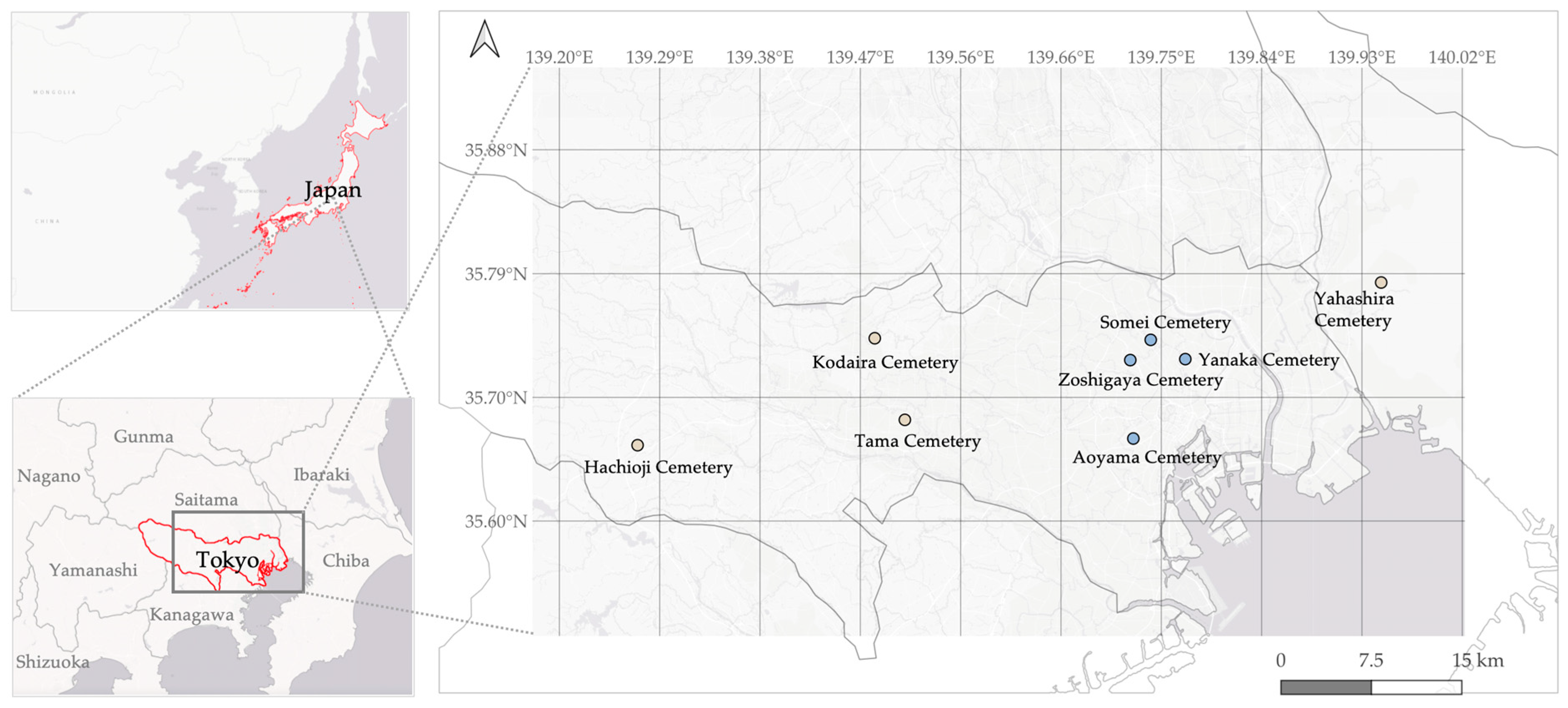
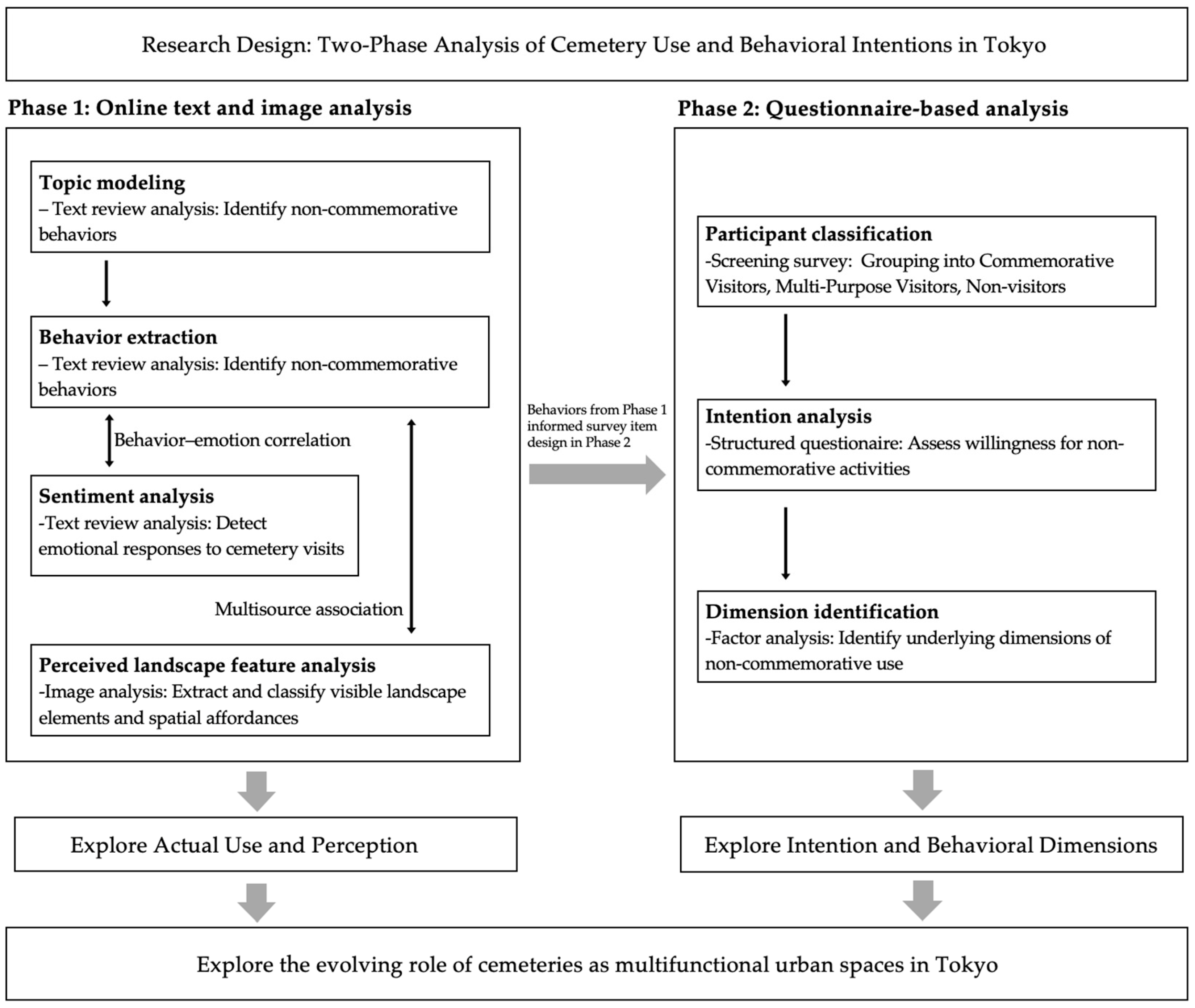
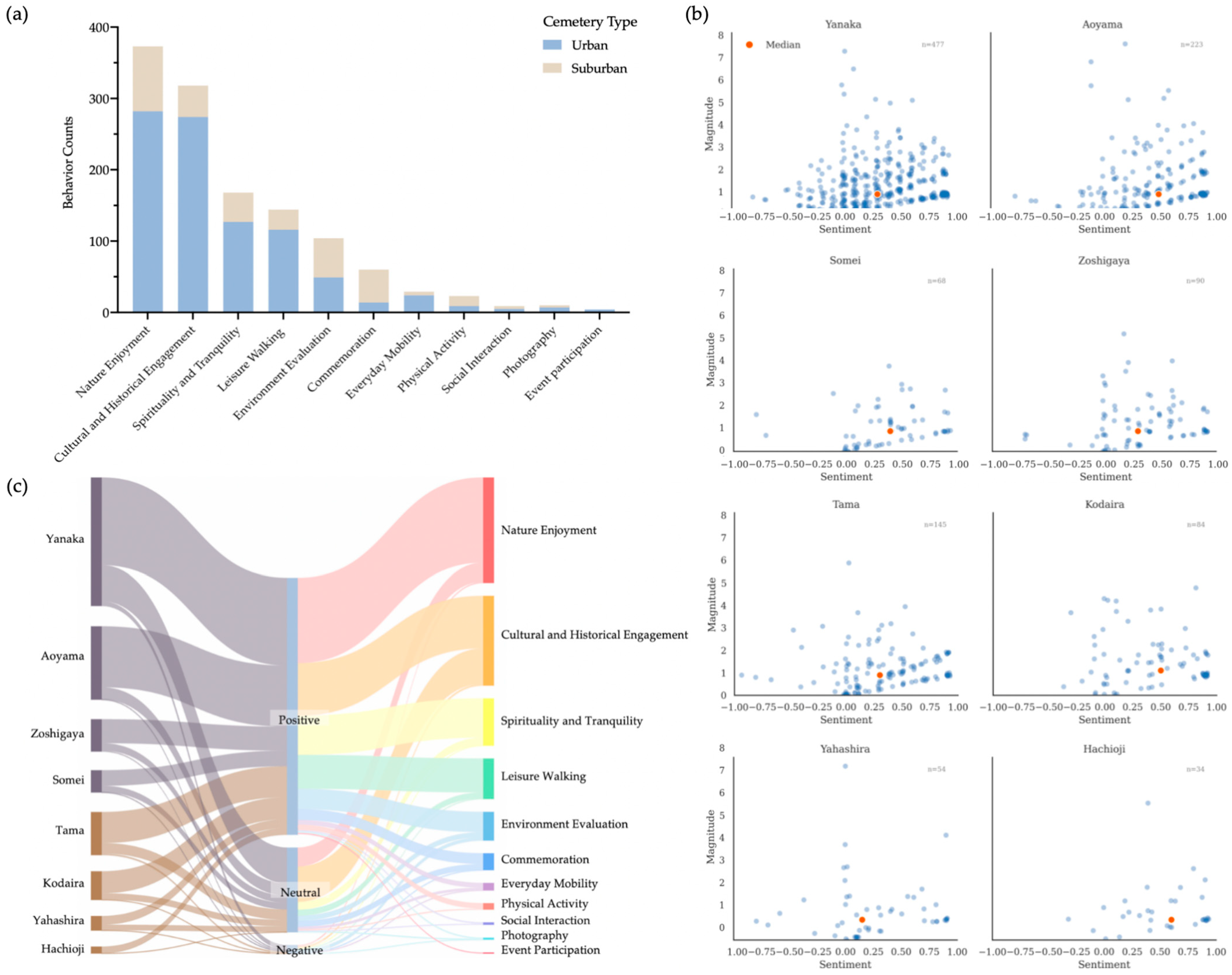
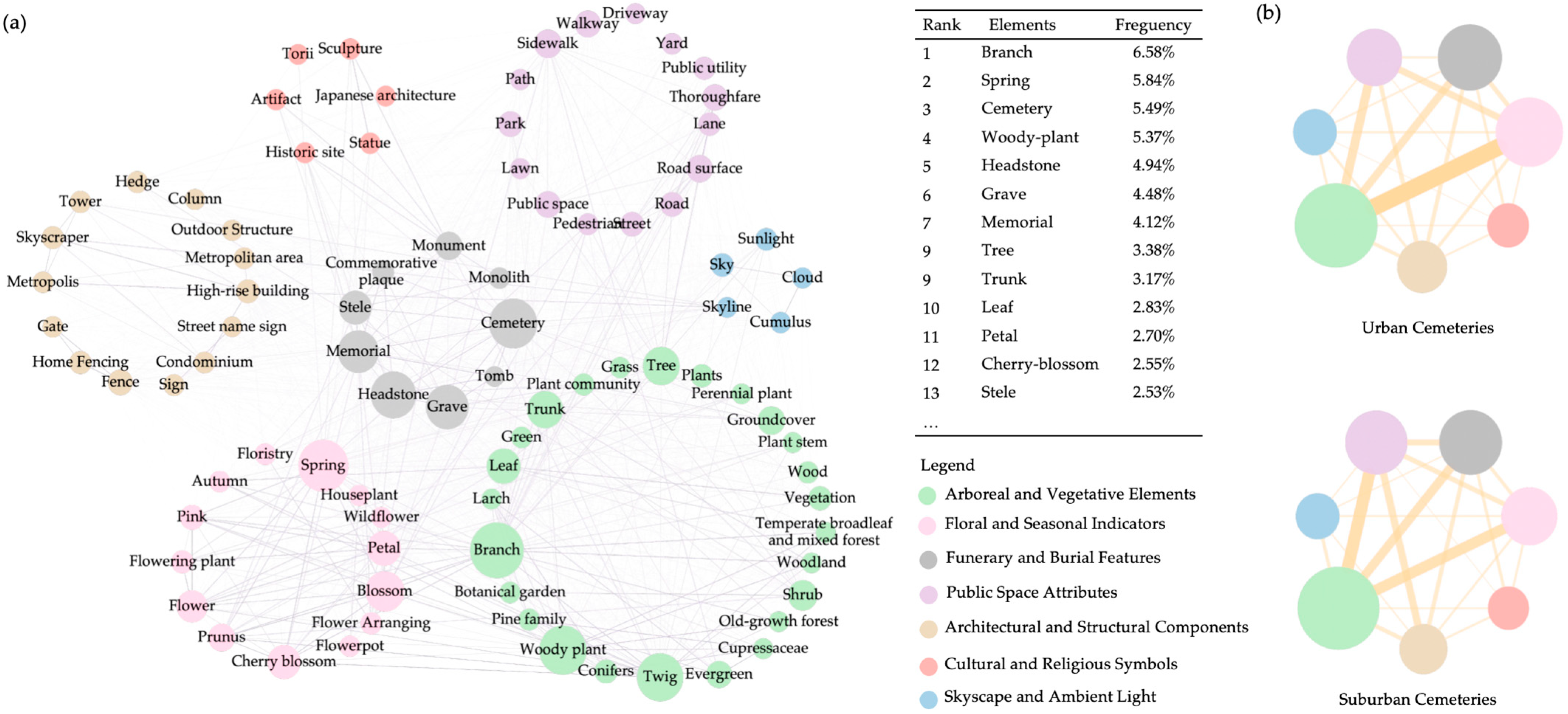
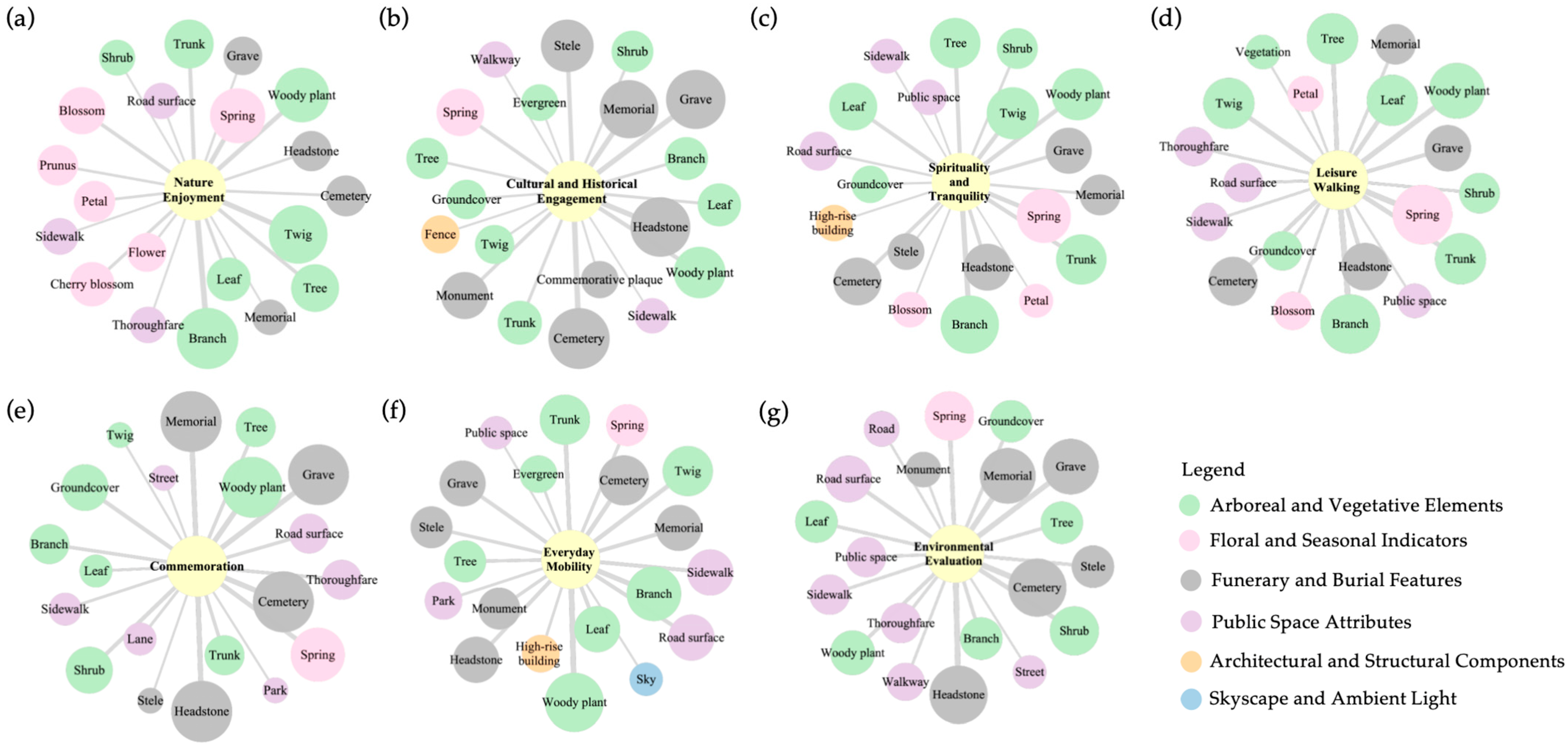
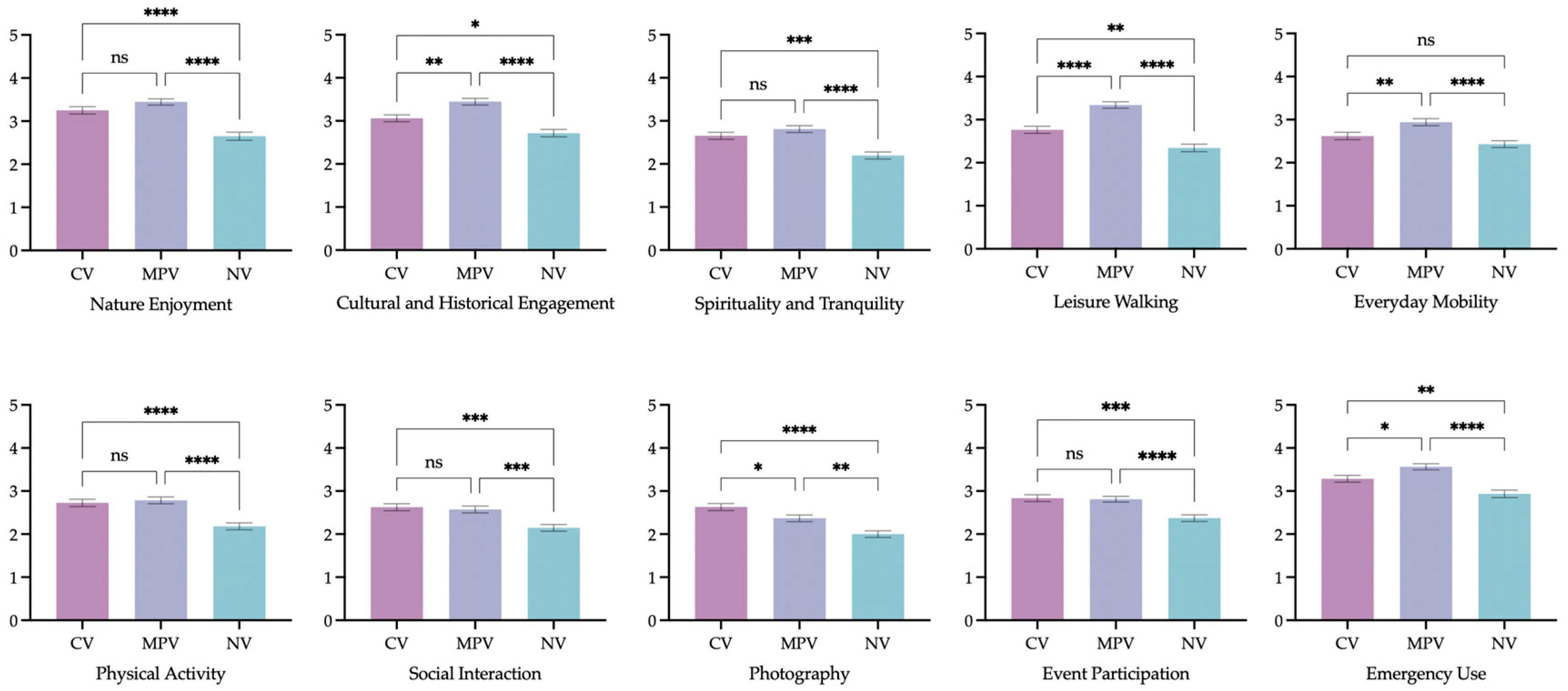


| Cemetery Type | Cemetery Name | Year Established | Area (ha) | Grave Area (ha) | Number of Burial Plots 1 | Landscape Elements | Surrounding Environments |
|---|---|---|---|---|---|---|---|
| Urban cemetery | Aoyama | 1874 | 26.4 | 12.8 | 15,887 | flat terrain; cherry-lined boulevards, tall red pine trees, cultural and political figures (e.g., Hachikō) | mixed-use central urban zone; surrounded by residential, offices, and commercial areas |
| Somei | 1874 | 6.8 | 3.5 | 4546 | flat terrain; cherry blossoms, graves of cultural and political figures (e.g., Takamura Kōun) | residential areas, local temples and community facilities | |
| Yanaka | 1874 | 10.3 | 5.1 | 6516 | open terrain with mature trees (248 trees over 150 cm); cherry-lined boulevards, historic temples (Tennōji, Kan’ei-ji), ruins of the Five-Storied Pagoda, graves of cultural and political figures (e.g., Tokugawa Yoshinobu) | residential areas, commercial areas (Yanaka Ginza shopping street), Nippori train station | |
| Zoshigaya | 1874 | 10.6 | 5.9 | 10,016 | flat terrain; mature zelkova trees, lush greenery, graves of cultural and political figures (e.g., Natsume Soseki) | residential areas, local temples and community facilities | |
| Suburban cemetery | Tama | 1923 | 128.0 | ~64 (50% of 128 ha) | 63,085 (excl. collective burials) | naturally sloping hillside; mixed forest and open lawns, cherry tree rows, red pines | residential area; adjacent to Musashino Park and Sengen-yama Park, community facilities |
| Yahashira | 1935 | 104.6 | ~52.3 (50% of 104.6 ha) | 74,625 (excl. collective burials) | gently undulating terrain with low hills and valley; French-style garden, Zelkova-lined avenue, pagoda-shaped water tower | low-density residential area; adjacent to a high school, small temples, warehouses and open land | |
| Kodaira | 1948 | 65.4 | ~32.7 (50% of 65.4 ha) | 40,391 (excl. collective burials) | flat terrain; zelkova-lined avenues, cherry trees, lawn areas, rigida pine, mixed woodland | low-density residential area; surrounded by wooded buffers | |
| Hachioji | 1971 | 64.4 | ~32.2 (50% of 64.4 ha) | 33,379 | open hills with 100 m elevation change; lawn graves, natural forest, seasonal flora | next to Takao Quasi-National Park; surrounded by nature and other cemeteries |
| Topics | Percentage (%) | Top Words and Text Sample | |
|---|---|---|---|
| 1 | Cultural and Historical Engagement | 26.72 | Top Words: tokyo, cemetery, tokyo metropolitan, old, district, famous people, graves, famous, yoshinobu |
| Text Sample: “Japanese cemetery in heart of Tokyo city is worth for you to experience different culture views of world after death.” | |||
| 2 | Management and Maintenance | 19.54 | Top Words: spacious, toilets, clean, rest, trouble, simply, blossoms blooming, distance, money, rest area |
| Text Sample: “It is always well maintained. It’s a great walking course with plenty of greenery, public toilets and benches.” | |||
| 3 | Seasonal Nature Experience | 17.96 | Top Words: cherry, cherry blossom, blossom season, blossoms beautiful, season, bloom, beautiful, sakura, best, street |
| Text Sample: “This is a beautiful place for cherry blossoms. The subdued colors of the gravestones and the gorgeousness of the cherry blossoms in full bloom create an indescribable, exquisite contrast. Unlike other famous cherry blossom spots, I think this is a place where you can feel the wabi-sabi beauty.” | |||
| 4 | Perceived Green and Spatial Environment | 6.81 | Top Words: tree, years, door, closed, size, big, temples, shop, unfortunately, yanaka |
| Text Sample: “The large ginkgo tree stands out against the blue autumn sky, creating a striking contrast. It is about 300 years old and has a trunk circumference of about 9 m. Skytree can be seen beyond the large ginkgo tree.” | |||
| 5 | Spiritual and Tranquil Experience | 4.34 | Top Words: city, relaxing, city center, calm, quiet, center, space, quiet place, place like, feels like |
| Text Sample: “It’s a quiet and calm place in the city center. I went there the other day for a walk. There are historic gravestones and monuments, and just walking around calms my mind. I recommend it if you want to spend some quiet time alone.” | |||
| 6 | Walking Experience | 5.62 | Top Words: walk, place walk, scary, walking, walking course, night, eat, careful, dog, good |
| Text Sample: “Very nice and quiet place to stroll, even during the evening. Doesn’t feel creepy or scary at all.” | |||
| 7 | Commemoration and Family Practices | 1.19 | Top Words: equinox, grass, traffic, graves, families, sun, relax, visiting cemetery, recent years, cross |
| Text Sample: “I went to visit my father’s grave during the equinox. It was a nice, warm day. The magnolias were blooming beautifully.” | |||
| 8 | Uncategorized | 17.79 | |
Disclaimer/Publisher’s Note: The statements, opinions and data contained in all publications are solely those of the individual author(s) and contributor(s) and not of MDPI and/or the editor(s). MDPI and/or the editor(s) disclaim responsibility for any injury to people or property resulting from any ideas, methods, instructions or products referred to in the content. |
© 2025 by the authors. Licensee MDPI, Basel, Switzerland. This article is an open access article distributed under the terms and conditions of the Creative Commons Attribution (CC BY) license (https://creativecommons.org/licenses/by/4.0/).
Share and Cite
Xu, Y.; Ma, R.; Furuya, K. Reimagining Urban Cemeteries: Behavioral Patterns, Perceptions, and Intentions in Tokyo’s Public Burial Landscapes. Land 2025, 14, 1638. https://doi.org/10.3390/land14081638
Xu Y, Ma R, Furuya K. Reimagining Urban Cemeteries: Behavioral Patterns, Perceptions, and Intentions in Tokyo’s Public Burial Landscapes. Land. 2025; 14(8):1638. https://doi.org/10.3390/land14081638
Chicago/Turabian StyleXu, Yunchen, Ruochen Ma, and Katsunori Furuya. 2025. "Reimagining Urban Cemeteries: Behavioral Patterns, Perceptions, and Intentions in Tokyo’s Public Burial Landscapes" Land 14, no. 8: 1638. https://doi.org/10.3390/land14081638
APA StyleXu, Y., Ma, R., & Furuya, K. (2025). Reimagining Urban Cemeteries: Behavioral Patterns, Perceptions, and Intentions in Tokyo’s Public Burial Landscapes. Land, 14(8), 1638. https://doi.org/10.3390/land14081638







